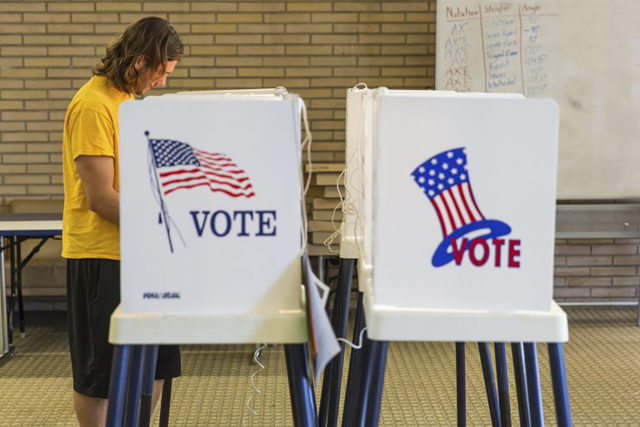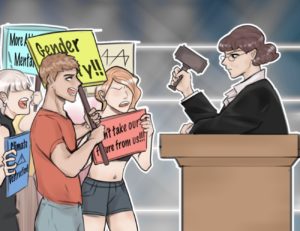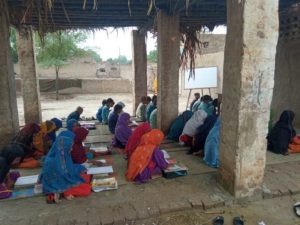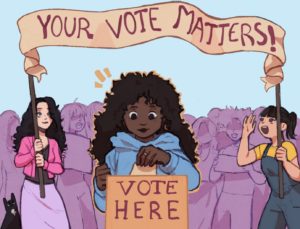This post was updated March 5 at 11:41 p.m.
It’s not a coincidence that a malicious individual like Andrew Tate has garnered so much attention from young boys on the internet.
Over the past decade, young women have become increasingly liberal while men have remained constant in their views.
Reasons behind this trend could be traced back to the Bring Back Our Girls movement of 2014, where people from across the globe rallied behind the slogan in retaliation to the kidnappings of schoolgirls in Nigeria, sparking conversations about gender-based violence.
The trend significantly spiked in 2017 with the #MeToo movement, when women challenged power structures through new terminology about sexual violence and misogyny. As a countermovement, some men circulated #NotAllMen, already demonstrating the divide in their social awareness and felt experiences.
While the pattern of women being more politically liberal than men is nothing new, the fundamental difference is that these trends appear to be growing in opposite directions in parts of the world, with some male groups becoming increasingly conservative.
To fully understand how gender has been influencing ideologies, we need to contextualize these trends against the sociopolitical dynamics and technological influences of the past and present. Especially in light of the upcoming 2024 United States election, students must stay informed of the social and ideological forces that control today’s politics.
Since the 1980s, politicians have become increasingly polarized, which means that they vote for increasingly different policies. Additionally, the general population has become more effectively polarized, which leads them to develop a stronger dislike towards members of the opposing party.
Many blame technology, specifically the echo chamber of social media, for exacerbating political polarization. Constant exposure to viewpoints we already agree with leads to confirmation of one’s political beliefs while reducing receptiveness to opposing perspectives.
This can have real-world consequences, which is apparent in many right-wing extremists such as Andrew Tate, who used social media to disseminate misogynistic ideologies.
Luwei Ying, an assistant professor in the Department of Political Science, found that many extremist leaders employ misogynistic or homophobic speech to create a sense of trust with their followers.
A prime example of this is when Tate said, “A woman’s true power lies in her ability to inspire and support her man.” This shows how extremists use social media to disseminate discriminatory ideologies among their followers.
Once figures like Tate become exceedingly popular, other people get pulled in, said Aaron Sehyeong Tae, a fourth-year data theory student.
“We have this divide where it’s one side against another,” Tae said. “Social media does have a big influence on this.”
The reasons behind misogynistic extremism are not new.
“Whenever groups that aren’t dominant tend to make some progress or contest the status quo, the groups that held on to power beforehand make retrenching moves,” said Emmanuel Mauleón, a professor in the UCLA School of Law.
Because women have frequently challenged the status quo in the past decade, with the #MeToo movement and backlash against the ruling of Dobbs v. Jackson’s Women’s Health Organization, some men have begun to feel threatened.
“Previously, if you were born as a man, you are guaranteed to be the well-off group in the society,” Ying said. “But now, women are gaining power and they (men) feel they are threatened by women, and that is why they disseminate so much hate online.”
Ju Hui Judy Han, an assistant professor in the Department of Gender Studies, said it’s unrealistic to achieve an equilibrium of power since society has not historically worked this way.
Therefore, men may perceive feminism as an effort for women to regain control of the hierarchy, since many men view gender rights as a zero-sum game.
However, there is hope. Research has confirmed that cross-partisan conversation can reduce polarization and counteract the online system set in place by these extremist groups.
While these recent trends in polarization show an interesting divergence involving gender, both Mauleón and Han added that the intersectionality of race and class are equally important when analyzing political ideology.
“If you start to break out groups by race, then you see that both white young men and white young women tend to trend much more conservative than Black people, brown people (and) other people of color to various degrees,” Mauleón said.
Therefore, these gendered trends in political ideology are hard to interpret without considering how other factors relate. However, reports from Gallup on this gender divide in young people do not address intersectionality.
Han said these statistics are sometimes exploited by power-hungry politicians who may benefit from furthering ideological polarization. Logically, it makes sense, given that rallying behind hatred of the opposing party gets more people emotionally involved.
On the other hand, people may also be using these statistics to predict voting behavior.
“There’s a lot at stake in national elections,” Han said. “So I think people are … trying to figure out which way the political winds will blow.”
This is true on a global level as well. In 2024, 49% of the world’s population will vote in national elections in 64 countries. This year will shape the world in years to come, making it an immensely critical and stressful time.
Unsurprisingly, many publications that evaluate these significant trends in political ideology – such as Forbes, the Financial Times and The Telegraph – all prominently feature countries that have important elections coming up this year: the U.S., the United Kingdom, Germany and South Korea.
The logical conclusion that follows is that new polls will try to predict political ideology and voting behavior, even if they are only considering part of the story. Any clue is better than nothing.
The last, critical piece of information that is missing from these trends concerns self-selection effects, which can lead to biased results.
Mauleón added that when researchers look for individuals to participate in polls that measure political ideology, they mainly obtain responses from people who claim a particular political ideology. It doesn’t measure the population as a whole but rather a subset of each demographic group.
“Even though young men who claim a political ideology tend to say that they’re more conservative, the vast majority of young men tend to not have any political ideology,” Mauleón said.
Ultimately, people with higher personal stakes in political outcomes will be more likely to voice their opinions. The diversity of intimate experiences profoundly shapes us, molding our identities, and political ideology is inexorably affected by this.
To all UCLA students: be considerate of the social dynamics as you enter the voting booths this year. For better or for worse, 2025 will look very different.





Comments are closed.